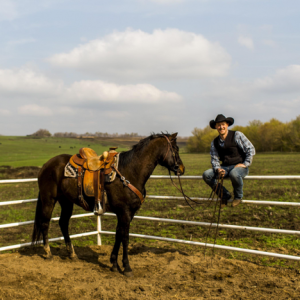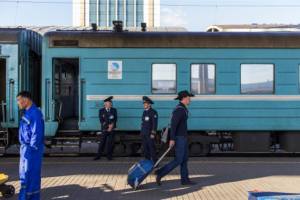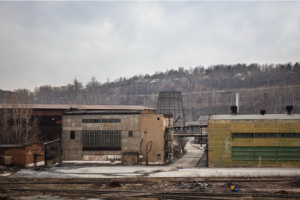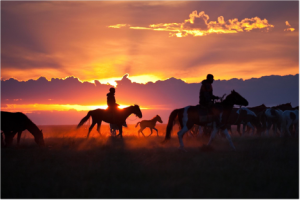
Ryan Bell, 2015-2016, Fulbright-National Geographic Storytelling Fellow to Russia and Kazakhstan, visiting the ranch he helped start in Voronezh, Russia. (Photo Credit: Michael Hanson)
The train was stopped at a border crossing between Russia and Kazakhstan. I opened my cabin door and saw three guards walking down the aisle. One carried an AK-47, another led a bomb-sniffing dog, and a third held a briefcase, presumably for processing each passenger’s immigration documents.
My passport and visas were in order; however, my cabin was not. The small table was crowded with my laptop, audio recorder, and notebooks. Camera equipment and clothing spilled out from my roller bag where it sat on one of the vacant bunks. A messy cabin would not make a good impression, so I hurried to tidy up before the guards reached my door.
(A Russian friend had let me in on a secret of traveling by rail: you can often get a four-person cabin all to yourself by reserving a bunk next to the bathroom. “It didn’t smell that bad,” she said.)
As a Fulbright-National Geographic Storytelling Fellow, I logged 33 travel days riding in a train car, zigzagging 23,780 miles across Russia and Kazakhstan. That’s just a few hundred miles short of matching the Earth’s circumference – 24,901 miles. Mobility was key for my research project Comrade Cowboys about farmers in Russia and Kazakhstan who were rebuilding their livestock industries with the help of cattle and cowboys imported from the United States.
The journey was something of a homecoming. From 2010 to 2011, I was among the first wave of American cowboys working in Russia. I helped a Montana rancher transport 1,450 Black Angus cattle, five Quarter Horses (a breed specialized for cowboy work), and a team of cowboys to start a 14,000-acre ranch in the Black Earth region of western Russia. They were breeding cattle, intended not for slaughter but for growing a cattle population that had shrunk by 50 percent since the collapse of the Soviet Union. Our job was to see the cattle through their first winter and spring, and train a group of villagers in ranch management so they could take over when we left.
In the years after our return to Montana, I continued working as a cowboy journalist. I often wondered what had become of that Russian ranch and the cattle industry I helped to create. Determined to find out, I applied for a Fulbright-National Geographic Storytelling Fellowship to go back to Russia five years later (including a side-trip to Kazakhstan, where a similar ranch-building movement was under way). The grant would not only help bring my experience full circle, it would give me a chance to work with editors at National Geographic, surely a boon to my journalism career.

Ryan Bell, 2015-2016, Fulbright-National Geographic Storytelling Fellow to Russia and Kazakhstan (right), at the train station in Astana, Kazakhstan. (Photo Credit: Michael Hanson)
The guards reached my cabin. The commanding officer searched my bags and when he saw my camera equipment, he looked at me with suspicion.
“The border checkpoint is a military zone,” he said. “Photography is forbidden. Did you take any pictures?”
“No sir,” I said.
“Prove it,” he said.
(See Ryan’s photo essay A Train To Siberia.)
I turned on the camera and scrolled through my most recent pictures, taken as the train wound through the Ural Mountains. After the last picture, the camera cycled back to the beginning of the memory card, showing images I’d taken on a cattle ranch in Bryansk, Russia. In the photos, an American cowboy drove cattle alongside several Russian herdsmen. The officer’s demeanor changed and he motioned for the other guards to look. Sensing that some true “cowboy diplomacy” would help, I turned on my laptop and showed them pictures of cowboys back in the American West.
The train conductor broke up the party, saying he had a schedule to keep. The immigration officer stamped my passport and wished me luck. As the train pulled out of the military checkpoint, I wondered which had carried more diplomatic weight: my passport or cowboy hat?

A factory town in the Ural Mountains of Russia. (Photo Credit: Ryan Bell)
Later that day, the train rolled across the Kazakh steppe and I saw groups of horsemen riding with their livestock. We were 100 miles from an archeological site known as the Botai Complex, inhabited 5,000 years ago by a culture of people believed to have been the first to domesticate horses. The herdsmen I saw out my train window were their cultural descendants. And while I’d never been to Kazakhstan before, I felt something like kinship with the Kazakh “cowboys.”
As I write this, a year has passed since completing my Fulbright-National Geographic Storytelling Fellowship. The experience has proven to be the professional stair step my journalism career needed. Working with top-notch editors made me more capable as a writer and photographer, and managing the tasks of a long-term research project has tested my ability to take an idea from concept-to-completion. There are tangible measurements of my success. My blog for NationalGeographic.com earned a Gold Award at the 2016 Lowell Thomas Travel Journalism Awards, and my image “Horse Foal in Rim Light” was a finalist for 2016 Travel Photographer of the Year. My experience reporting about Russia and Kazakhstan has led to an ever-expanding portfolio of publications, including stories for NPR, the Columbia Journalism Review, and a continued working relationship with National Geographic.

Horsemen riding across the Kazakh steppe. (Photo Credit: Ryan Bell)
Perhaps the most meaningful outcome has been producing stories that help people see a cultural bridge connecting the pastoral peoples of the United States, Russia, and Kazakhstan.
Note: If you’re interested in applying for a Fulbright-National Geographic Storytelling Fellowship, checkout my blog Tips for Applicants over on NationalGeographic.com. For updates about my work, find me on Twitter and Instagram.
Have questions for Ryan about his Fulbright experiences in Russia and Kazakhstan, and as a Fulbright Alumni Ambassador? You can reach him at R.Bell.alumniambassador@fulbrightmail.org.



No Comments